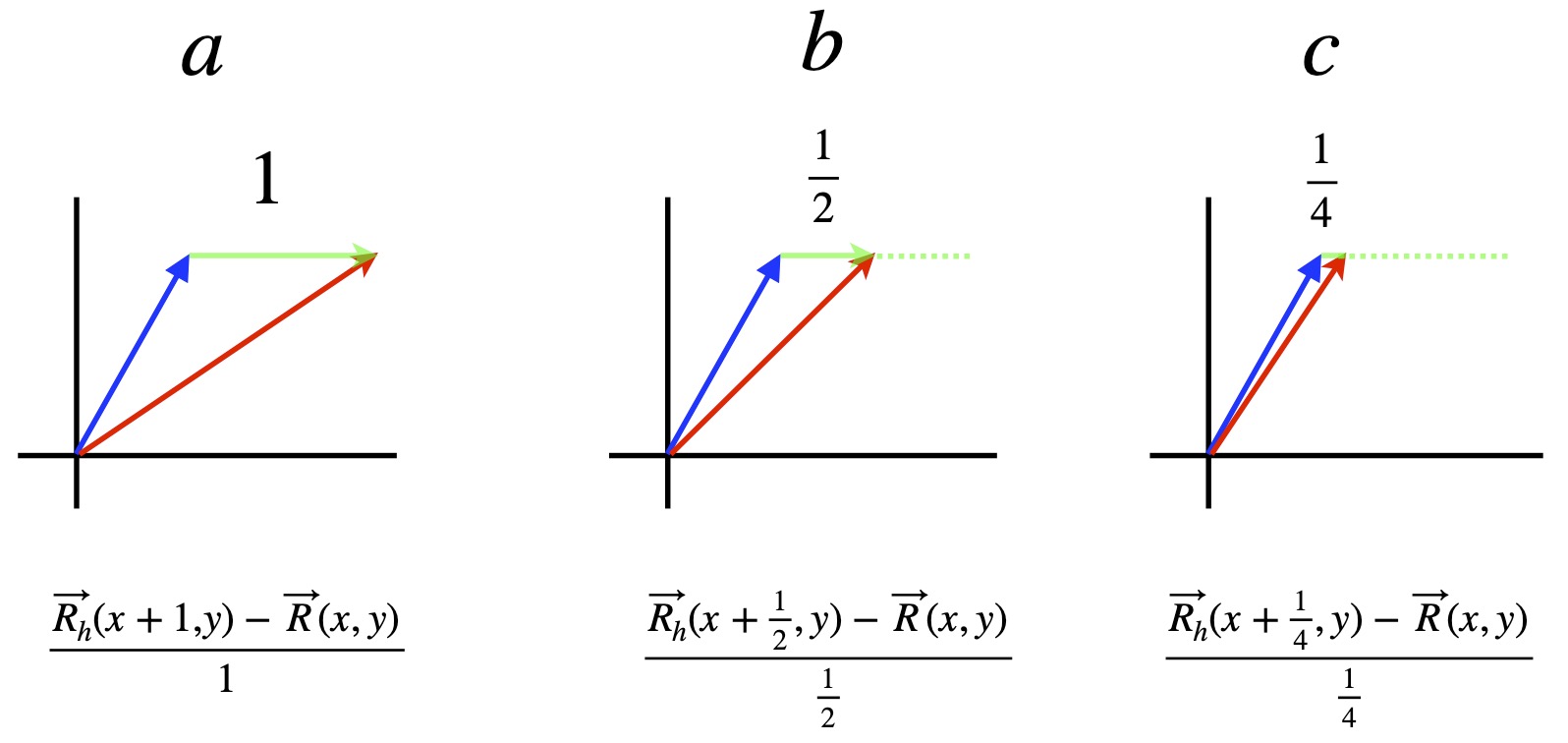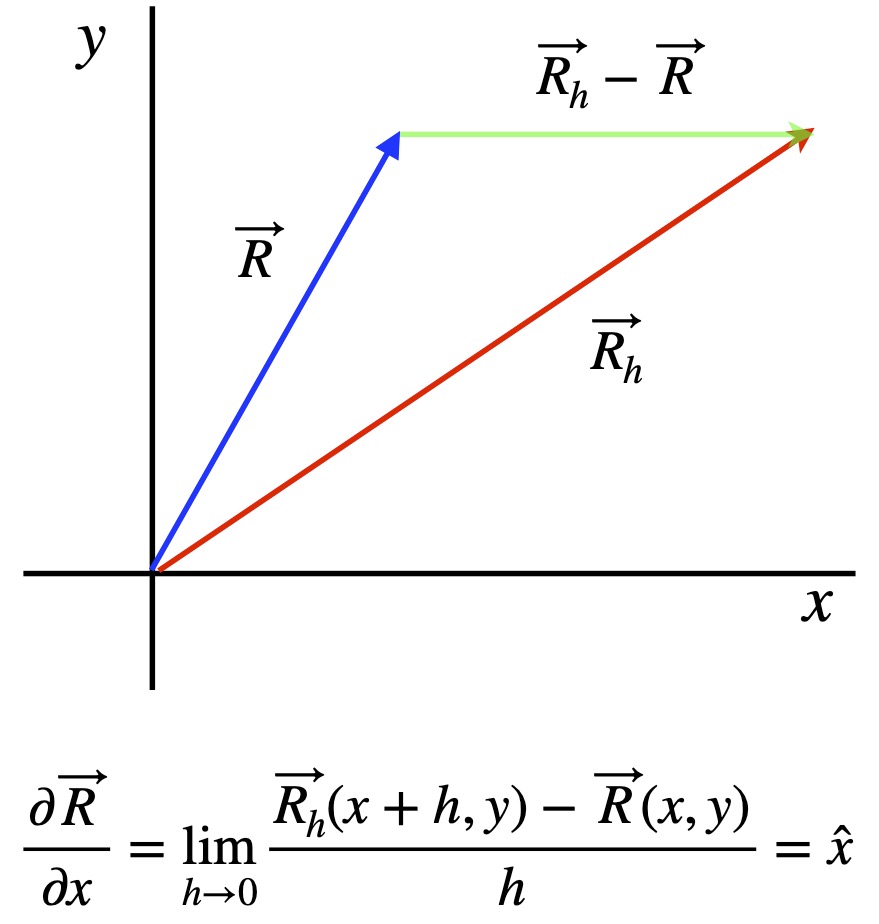Table of Contents
- Polar Coordinates
- Cylindrical Coordinates
- Spherical Coordinates
- Vector components in rotated Cartesian coordinates
- Basis vector rotation in Cartesian coordinates
Polar Coordinates
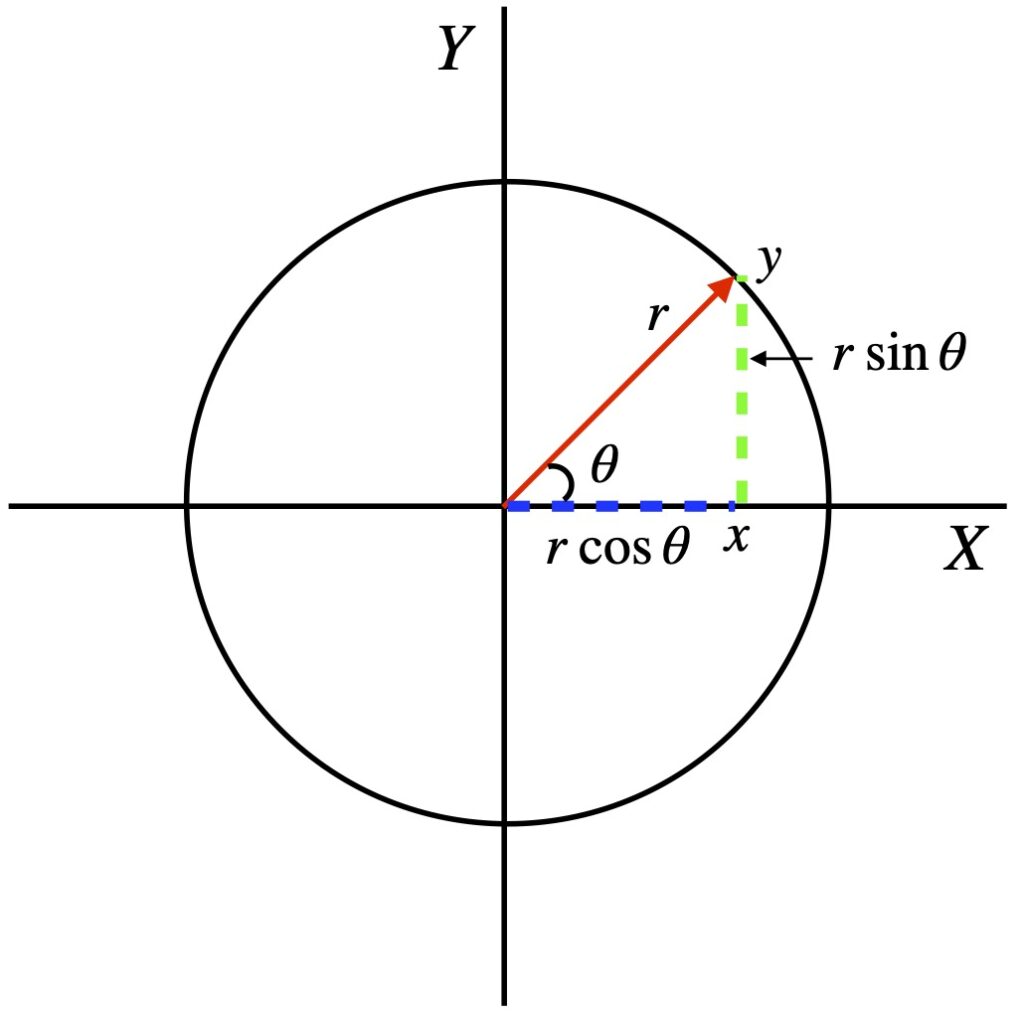
Coordinates
![]()
![]()
![]()
![]()
Basis Vectors
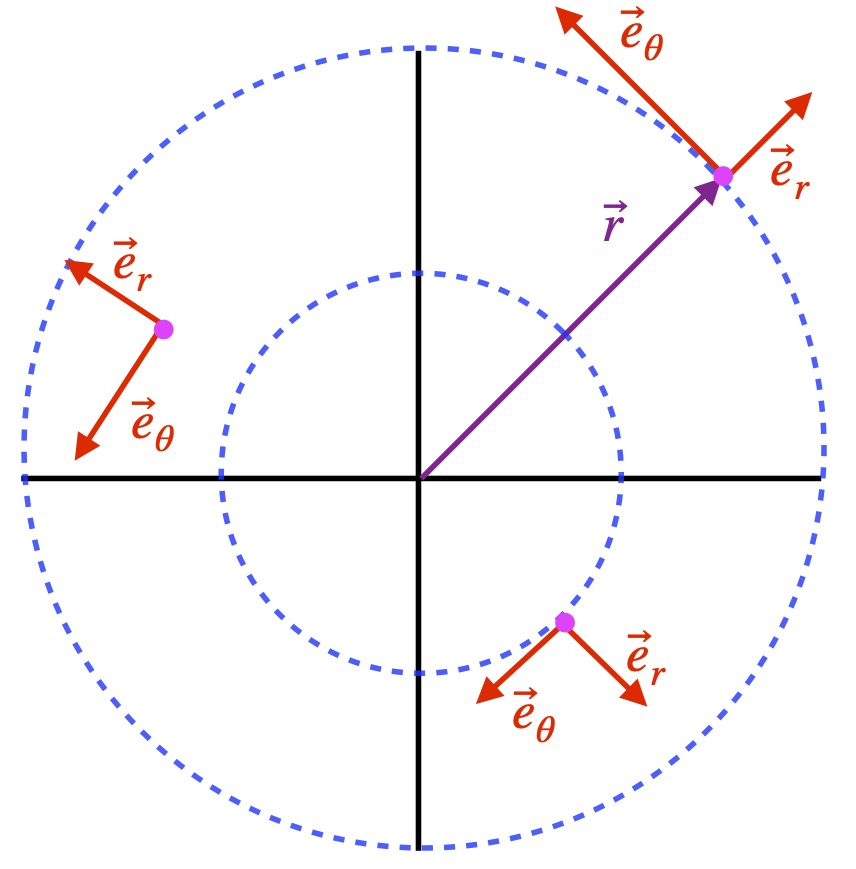
We can define the vector ![]() in terms of Cartesian basis vectors:
in terms of Cartesian basis vectors:
![]()
![]()
We express any basis vector as a partial derivative:
![]()
![]() is a vector tangent to
is a vector tangent to ![]() in the u direction. If we want to get a unit vector, we need to normalize
in the u direction. If we want to get a unit vector, we need to normalize ![]() by dividing it by
by dividing it by ![]() .
.
To see why, ![]() click :
click :
Applying this to eq (), we get:
![]()
![]()
and
![]()
![]()
Notice that, unlike the Cartesian basis vectors ![]() and
and ![]() , which are the same length and point in the same direction elsewhere, polar basis vectors vary. Specifically:
, which are the same length and point in the same direction elsewhere, polar basis vectors vary. Specifically:
 varies in direction with
varies in direction with  but is constant in length.
but is constant in length. also varies its direction with
also varies its direction with  . However, in addition, its length scales with
. However, in addition, its length scales with  .
.
If we’re working with a unit circle i.e., ![]() , then we can ignore the
, then we can ignore the ![]() in our equation for
in our equation for ![]() . However,
. However, ![]() scales with
scales with ![]() . Note that some authors normalize the expression for
. Note that some authors normalize the expression for ![]() by dividing by
by dividing by ![]() .
.
It’s also easy to show that ![]() and
and ![]() are orthogonal. By definition, vectors are orthogonal if their dot product equals zero. For
are orthogonal. By definition, vectors are orthogonal if their dot product equals zero. For ![]() and
and ![]() , we have:
, we have:
![]()
Figure X is designed to provide visual intuition about why basis vectors in polar coordinates are what they are. Figure Xb is a blow-up of the area in figure Xa enclosed in the dotted blue circle. In this figure, we’re assuming that all basis vectors are normalized.
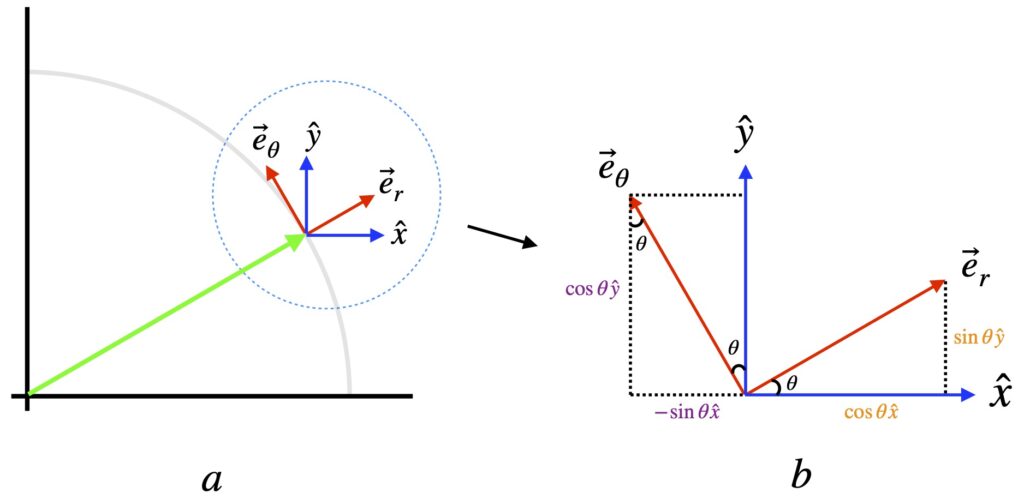
We can express Cartesian basis vectors in terms of polar basis vector, as follows:
![]()
![]()
Figure X may be helpful to understand these equations better.
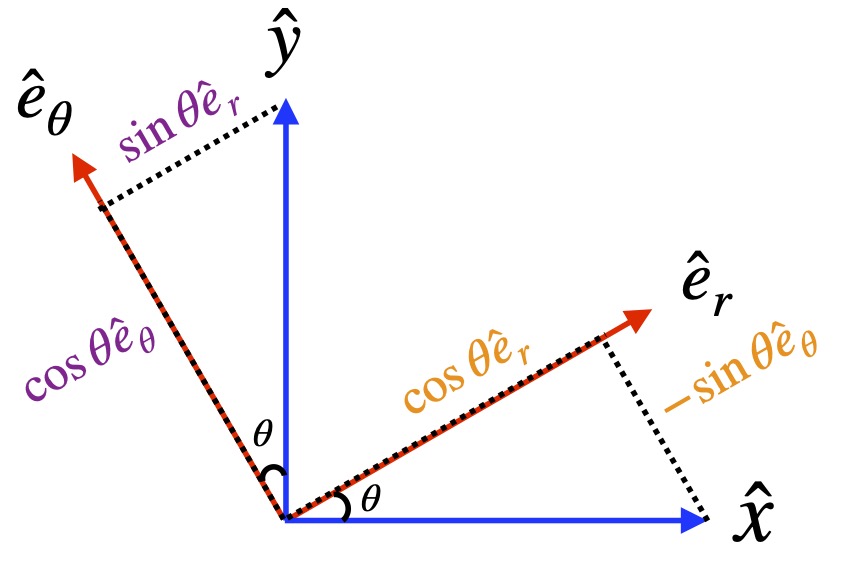
Line Element
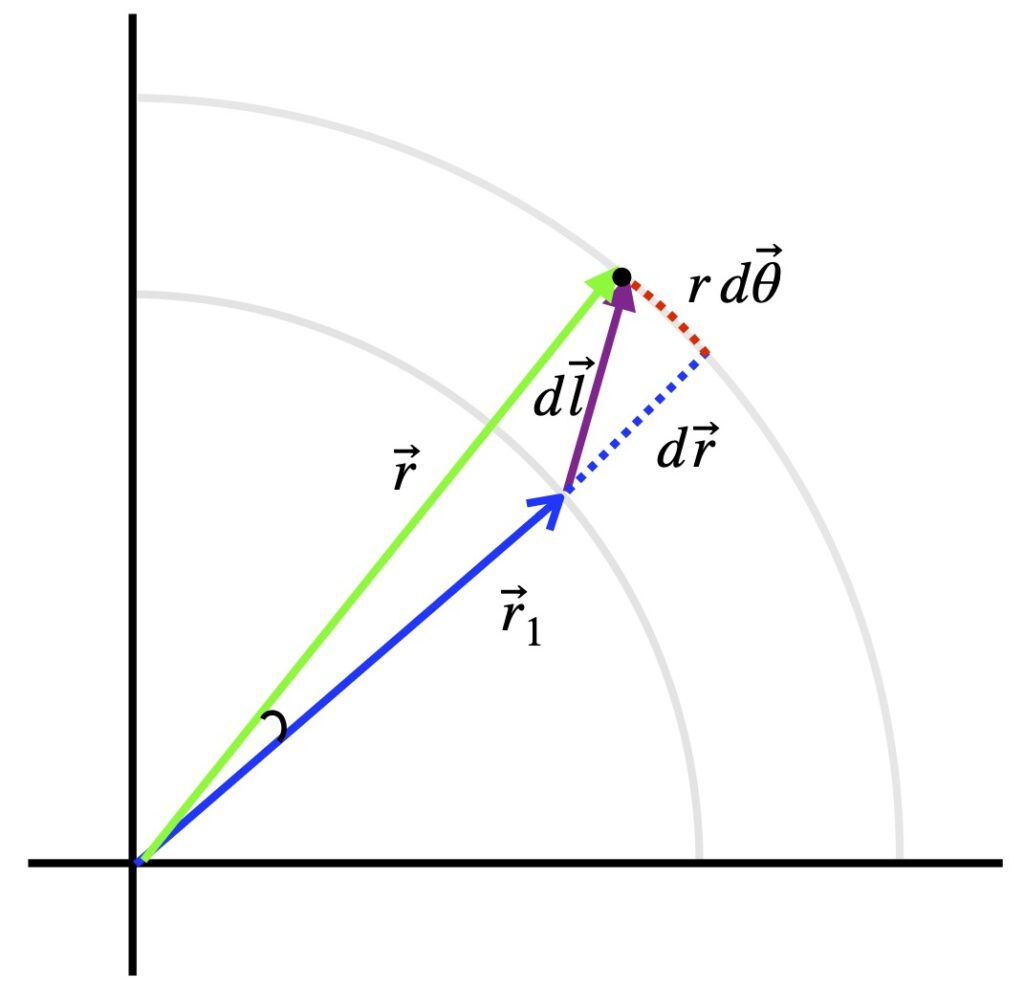
Anticipating derivation of the metric in polar coordinates, this section is designed to determine the line element in polar coordinates.
Referring to figure X (obviously not drawn to scale), we seek to find the infinitesimal displacement vector, ![]() , as we move radially outward and counterclockwise from the tip of
, as we move radially outward and counterclockwise from the tip of ![]() to the tip of
to the tip of ![]() . The radial component is just
. The radial component is just ![]() . The component in the direction of
. The component in the direction of ![]() is the arc length between the outer tip of
is the arc length between the outer tip of ![]() and the outer tip of
and the outer tip of ![]() which, in general, is the product of the radius times the angle
which, in general, is the product of the radius times the angle ![]() in radians. Thus, we can write:
in radians. Thus, we can write:
![]()
The line element, which is the length of the infinitesimal displacement vector – like the length of any vector – is given by the dot product of the infinitesimal displacement vector with itself. In polar coordinates, then, the line element is:
![]()
Cylindrical Coordinates
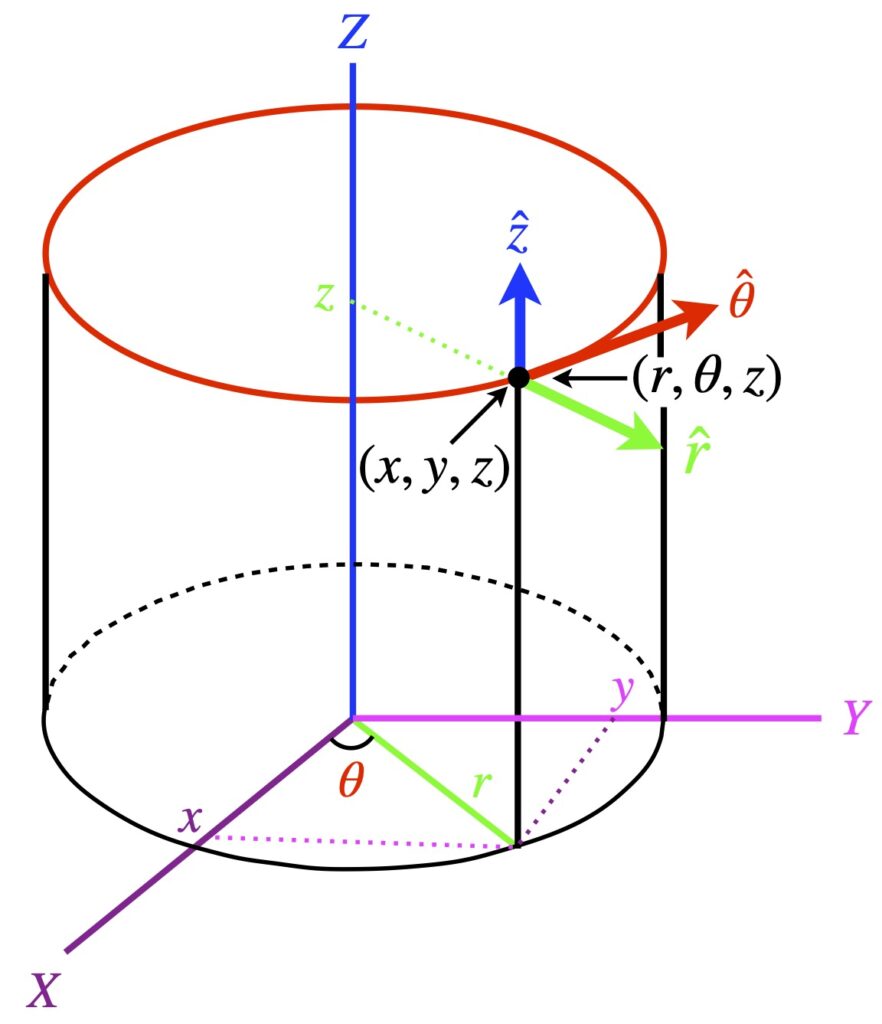
Cylindrical coordinates are similar to polar coordinates but with the addition of a z-coordinate that is equal to the Cartesian z-coordinate. Because I’ve gone through derivations for polar coordinates in the previous section, I won’t repeat them; instead, I’ll just catalogue the results.
Coordinates
![]()
![]()
![]()
![]()
![]()
![]()
Basis Vectors
Polar basis vectors in terms of Cartesian basis vectors:
![]()
![]()
![]()
Cartesian basis vectors in terms of Polar basis vectors:
![]()
![]()
![]()
Line Element
![]()
Spherical Coordinates
Coordinates
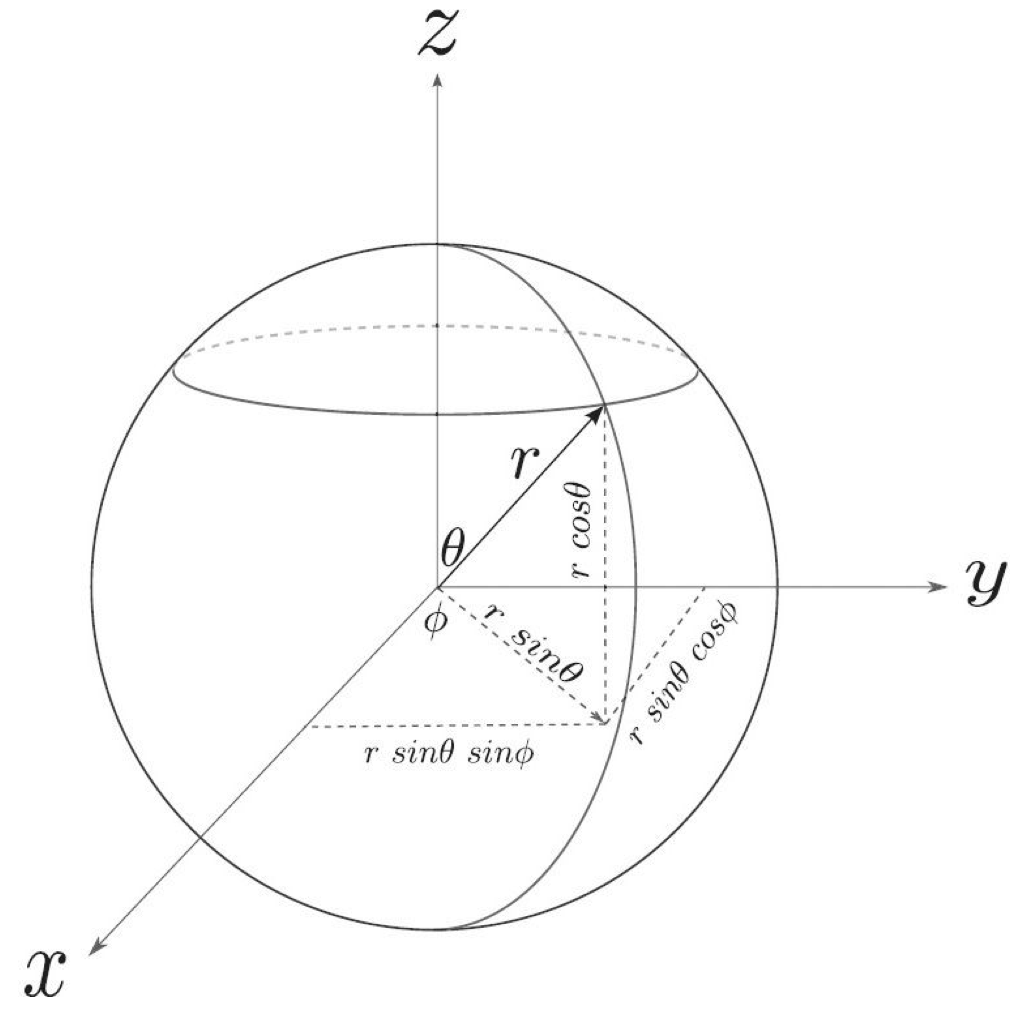
From figure X, we glean that:
![]()
![]()
![]()
Basis Vectors
We can describe the vector ![]() as follows:
as follows:
![]()
Substituting the coordinate conversions from the last section, we have:
![]()
![]()
Back in our derivation of polar basis vectors, we discovered that
![]()
We make use of these relationships to find each of the spherical coordinate basis vectors: ![]() ,
, ![]() and
and ![]() We’ll start with
We’ll start with ![]() .
.
![]()
![]()
![]()
To normalize ![]() , we have to divide by
, we have to divide by ![]() :
:
![]()
![]()
![]()
![]()
![]()
So,
![]()
![]()
![]()
Deriving ![]() and
and ![]() are a bit more involved. Next we’ll look at
are a bit more involved. Next we’ll look at ![]() .
.
![]()
![]()
![]()
To normalize ![]() we need to divide it by its length. Thus,
we need to divide it by its length. Thus,
![]()
![]()
![]()
![]()
![]()
That means that:
![]()
![]()
![]()
Finally, we’ll derive ![]() . We begin with:
. We begin with:
![]()
![]()
![]()
![]()
To normalize ![]() , we need to divide it by its length. We get the length as follows:
, we need to divide it by its length. We get the length as follows:
![]()
![]()
![]()
![]()
And dividing by that length, we get:
![]()
![]()
![]()
To summarize, the basis vectors in spherical coordinates are:
![]()
![]()
![]()
The last thing I’d like to do in this section is prove that the spherical coordinate basis vectors are orthogonal. To do this, we show that the dot products of the basis vectors equals zero.
![]()
![]()
![]()
![]()
![]()
![]()
Line Element
We’ll first derive the line element in spherical coordinates by a method I’ll call the algebraic method.
In Cartesian coordinates, the line element is:
![]()
We know that:
![]()
![]()
![]()
The total derivative is defined as:
![]()
Using this on eq (), we have:
![]()
![]()
![]()
Then
![]()
![]()
![]()
![]()
Note that the squared terms in the equation above actually represent the dot product with itself (e.g., ![]() really means
really means ![]() . I’ve used the squared shorthand to save space, in the equation above and in the equations that follow in this section.
. I’ve used the squared shorthand to save space, in the equation above and in the equations that follow in this section.
We showed, in the last section, that the spherical coordinate basis vectors are orthogonal. Therefore, terms multiplied by ![]() ,
, ![]() and
and ![]() will all be zero. The only terms that survive are the
will all be zero. The only terms that survive are the ![]() ,
, ![]() and
and ![]() terms.
terms.
For the ![]() term:
term:
![]()
![]()
![]()
![]()
For the ![]() term:
term:
![]()
![]()
![]()
![]()
![]()
For the ![]() term:
term:
![]()
![]()
![]()
So the line element we’re left with is:
![]()
We can gain further intuition as to why the line element for spherical coordinates are what they are by examining figure X.
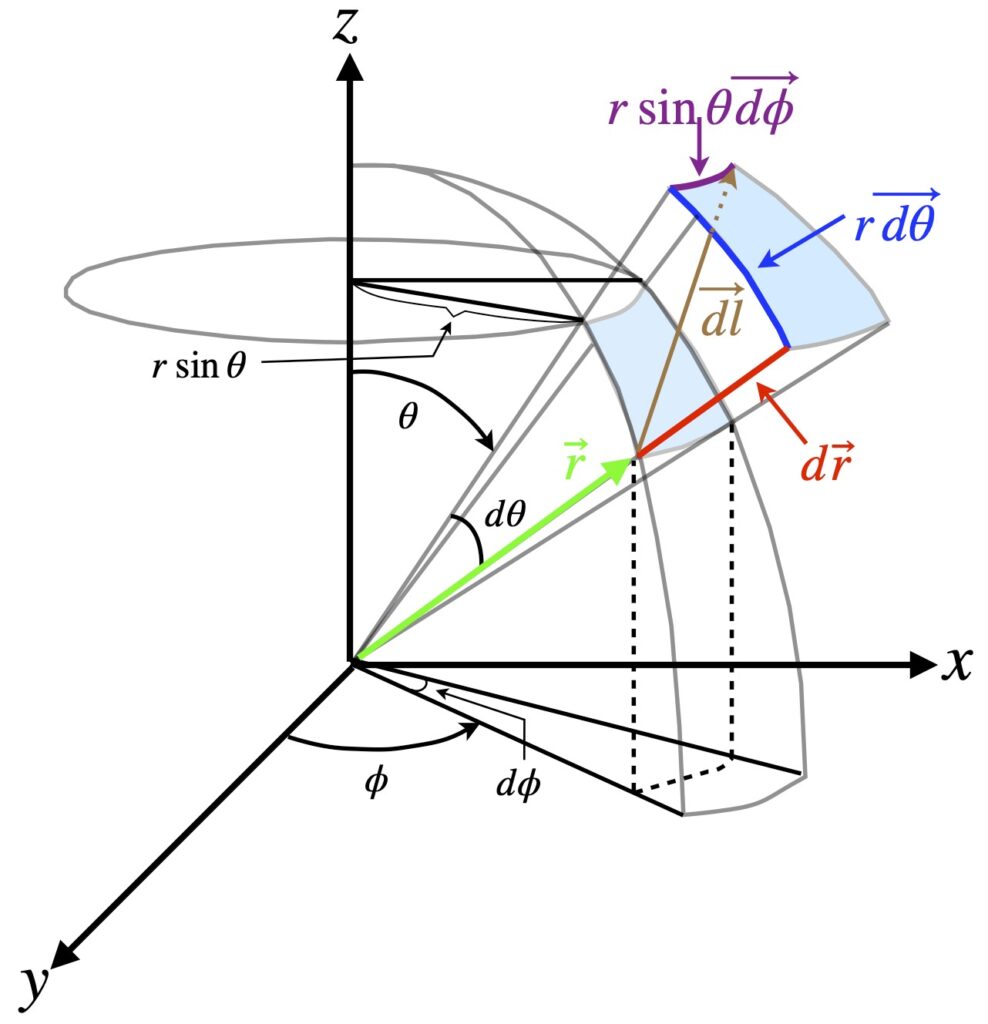
Figure X (obviously not drawn to scale) shows an infinitesimal spherical volume element. But that’s not what we’re actually interested in here. What we’re interested in is ![]() (colored brown in the diagram). It represents an infinitesimal displacement made from:
(colored brown in the diagram). It represents an infinitesimal displacement made from:
- An infinitesimal displacement in the radial direction with magnitude 1 (shown in red)
- An infinitesimal displacement in the
 direction with magnitude
direction with magnitude  (shown in blue)
(shown in blue) - An infinitesimal displacement in the
 direction with magnitude
direction with magnitude  (shown in purple)
(shown in purple)
We obtain the magnitude of the ![]() -direction infinitesimal vector by recognizing that that vector is a tiny arc on a sphere. In general, the length of an arc is given by the radius of the sphere times the angle subtended by the arc in radians. In the case of the
-direction infinitesimal vector by recognizing that that vector is a tiny arc on a sphere. In general, the length of an arc is given by the radius of the sphere times the angle subtended by the arc in radians. In the case of the ![]() -direction vector, the radius is
-direction vector, the radius is ![]() and the angle subtended by the arc is
and the angle subtended by the arc is ![]() .
.
Similarly, the magnitude of the ![]() -direction infinitesimal vector is given by the radius,
-direction infinitesimal vector is given by the radius, ![]() (derived above), times the magnitude of the angle in the
(derived above), times the magnitude of the angle in the ![]() direction,
direction, ![]() .
.
Thus, we can express the infinitesimal displacement vector, ![]() as:
as:
![]()
The length of ![]() – which, by definition, is the line element
– which, by definition, is the line element ![]() – is arrived at by taking the dot product of
– is arrived at by taking the dot product of ![]() with itself:
with itself:
![]()
![]()
![]()
Vector Components in Rotated Cartesian Coordinates
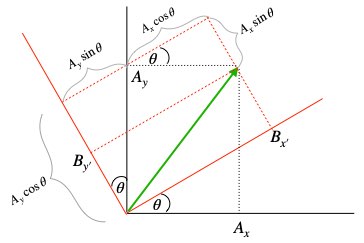
Components in A and B coordinates:
![]()
![]()
From the diagram, we can see that:
![]()
![]()
Rearrange:![]()
![]()
Write the above equation in matrix form:
![]()
Basis vector rotation in Cartesian coordinates
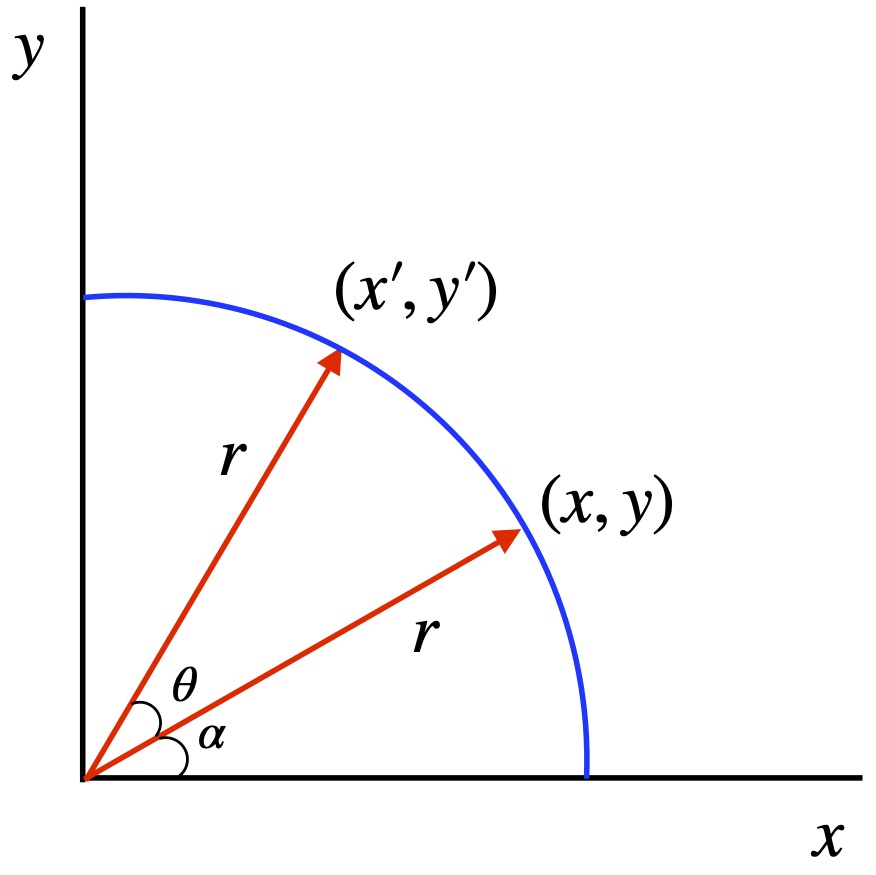
![]()
![]()
and
![]()
![]()
Using the appropriate trigonometric identities, we have:
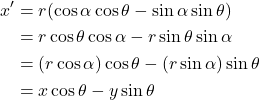
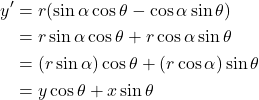
In matrix form:
![]()

